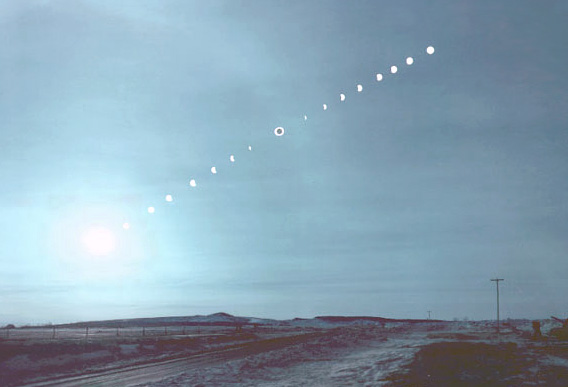Total Solar Eclipse of 26 February, 1979.
|
|
Images of the 26 February, 1979 Total Solar Eclipse.
Contents: |
Introduction:
|
The following images are from my total solar eclipse expedition to Montana for the 26 February, 1979 total solar eclipse. This was my first total solar eclipse expedition. It was also the shortest in terms of distance, since the center of the eclipse path was only about 800 kilometers from my home in Colorado. We observed the eclipse from a site 3 kilometers south of the small town of Grassrange, Montana. I had the pleasure of going to this eclipse with my father and my brother. While in Montana, we had a chance encounter with friends Norman Duecker, Louis Lubeski, and Carl Morris.
On this eclipse expedition, I brought almost all of my cameras (which was not a good idea) and had not practiced my procedures very much. I got some results, but my corona shots were not as good as those taken by others who had brought a more modest amount of equipment. At that time, I did not have a complete set of lenses for any one brand of camera, so I just used the equipment I had on hand or whatever I could obtain or rent for the least cost. Therefore, my equipment included Canon, Keystone, Kodak, Minolta, Miranda, Nikon, Rollei, and Yashica cameras. I have since (as of when this was written in 1998) standardized on Nikon film cameras. I would have considered Minolta if their new cameras had appealed to me as much as Nikon back in the 80's. I wanted to be sure I could continue to get cameras having removable pentaprisms in order to facilitate easier astrophotography. Standardization allowed me to own fewer cameras and lenses, yet have more capability. Many aspects of the 1979 eclipse took me very much by surprise. I was so caught up by it all that I forgot to do a number of things. I forgot to turn on my movie camera during totality, and I forgot to look at the eclipse through my binoculars - even though I had them on me the whole time! The outer corona was not visible due to cirrus clouds, but these same clouds enhanced the view of the lunar umbra. By far, what impressed me most was the lunar umbra, which put on a totally breathtaking show. Fortunately, I had brought a camera with a fisheye lens and I succeeded in capturing a few umbral images just before and just after totality. I did not take umbral photos during totality, partly because I was so taken in by the sight that taking a picture didn't even occur to me. However, I did produce a drawing of the umbra as it appeared about 40 seconds after second contact. During totality, I could clearly observe motion of the leading edge of the umbra as it rapidly moved toward the east-northeast. In addition to observing umbral motion, I was able to see yellow, orange, and even red color around the horizon. This experience is what inspired me to take 360 degree panoramas at all subsequent total solar eclipses I observed. I used these later panoramas in umbral predictions, with the emphasis being on determination of the altitude at which the boundary of the umbra is visually the most prominent as it is projected onto the earth's atmosphere. The corona and umbra images follow. |
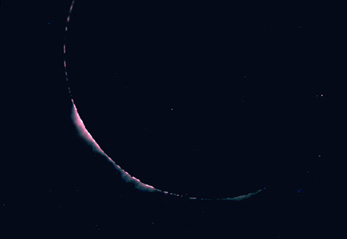 |
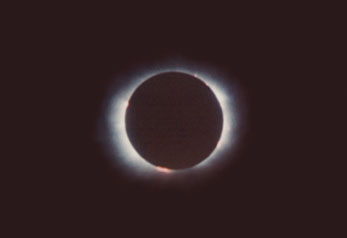 |
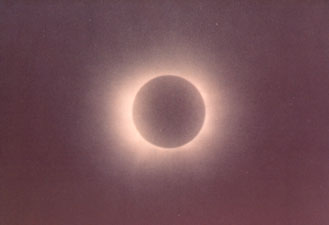 |
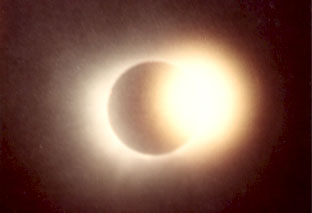 |
| Total Solar Eclipse of 26 Feb. 1979. Drawing (upper left) and Corona Photos. | |
| The UPPER LEFT image
is a drawing I made of the chromosphere at 2nd contact, with only a notional lunar limb profile. The UPPER RIGHT image was taken with a 300 mm f/4.5 lens and a 2x teleconverter. The exposure was one second at f/45 on Ektachrome 200 film which was push processed 1 stop. (Lacking an attachable solar filter for the partial phases, I had stopped the lens down to f/45 to keep the solar image from frying my focusing screen, then forgotten to open the aperture during totality. Oops!) The LOWER LEFT image is a one second exposure with a Rolleiflex SL66 and a 250 mm f/5.6 Sonnar lens on ASA 400 color print film. (ASA was later supplanted by ISO.) The inner corona was overexposed in the original, but radial dodging brought out some of the detail. The outer corona was not visible due to thin clouds. The LOWER RIGHT image shows the diamond ring at third contact. The image is a composite of an image taken with the 300 mm lens and teleconverter, and one taken with the 250 mm Sonnar lens. The diamond ring effect was pronounced and short lived due to scattering from local cirrus clouds. | |
Return to Local Table of Contents
Sequence of Partial and Total Eclipse Phases (1979)
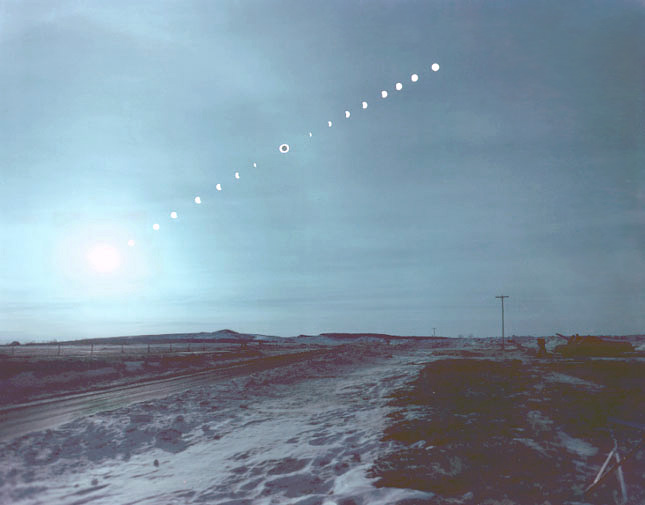
| |
| Total Solar Eclipse of 26 Feb. 1979. Sequence Image taken with 4x5" Film Camera. | |
| Sequence of partial and total eclipse phases. The base image was taken before first contact with a 4 x 5 inch camera and a 90 mm f/6.8 Angulon lens. The sequence image was taken on Kodalith film (having an ASA of about 6) with the same camera and lens, plus a mylar solar filter. High contrast Kodalith film was used to minimize base fogging that could result from scattering by the mylar solar filter. The two negatives were then sandwiched to produce this image. |
Return to Local Table of Contents
Panoramic and Wide Angle Images of the 1979 Lunar Umbra:
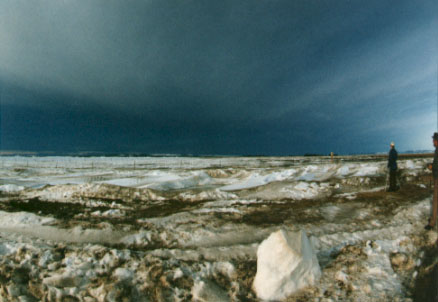 |
 |
| The Umbra Approaces, Seconds Before 26 Feb. 1979 Total Solar Eclipse (130 Degree FOV) | |
| The umbra approaches our site. These 130 degree wide images of the 26 Feb. 1979 total solar eclipse were taken toward the west on ASA 100 print film, with a Minolta SRT 101 camera and a 16 mm f/2.8 Rokkor-X full frame fisheye lens. The LEFT image shows the umbra 65 seconds before totality. It was exposed for 1/15 second at f/4. The RIGHT image was taken about 10 seconds before totality and exposed for 1/4 second at f/4. The bright color near the horizon on the left side of the picture is sunlight beyond the trailing edge of the lunar umbra. | |
 |
|
| Rendering of Lunar Umbra During 26 Feb 1979 Total Solar Eclipse (170 Degree FOV) | |
| An umbral view to eclipse all others is shown in this 170 degree wide image (composite of photos and a drawing) with east-southeast in the center. The small white objects in the sky just left of center are sunlit clouds which were visible through the moon's shadow. I watched this scene for some time (until over 40 seconds after 2nd contact), but was so taken in by it that I did not shoot a picture! The experience impressed me so much that I started this drawing in the car while on the way back from the eclipse. A few weeks later, the drawing was merged with photos I had taken of the horizon. More recently (circa 1998) digital image processing was used to make the darker part of the sky more realistic than the original drawing. The sky was not black at this eclipse, but it was not an entirely consistent gray-blue either, so the image still needs some work. This sight is what inspired me to take multiple 360 degree panoramas at future total solar eclipses. | |
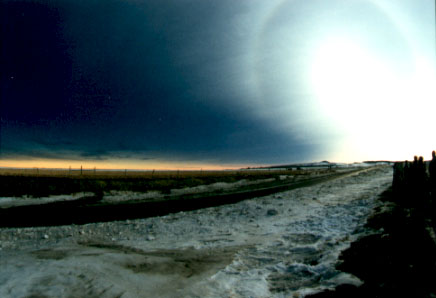
| |
| Lunar Umnra Projected onto Thin Clouds at 26 Feb. 1979 Total Solar Eclipse | |
| The rounded edge of the umbra is obvious in this image, which was taken 13 seconds after the end of totality with a 16 mm fisheye lens. The exposure was 1/15 second at f/4. This is a completely unprocessed image, scanned directly from a straight machine print. Due to its large angular size, the umbra was not obvious to the naked eye after totality, though a fisheye "door peeper" lens would undoubtedly provide a clear view. I brought a door peeper to most subsequent eclipses. This and all other images Copyright © 1979, 1998, 2017 Jeffrey R. Charles. All Rights Reserved. | |
Return to Local Table of Contents
|
Equipment used for the 26 Feb. 1979 total solar eclipse had to more or less be limited to cameras and lenses that I already had. This mostly due to financial and time constraints. It was not a good situation, because for financial reasons, my equipment had been acquired gradually over years, and it consisted of multiple brands and formats of cameras and lenses, with many of the cameras having different lens mounts.
Shortly before the 1979 eclipse, I acquired a couple of small tripods at a garage sale. Combined with borrowing my dad's Albert tripod, this increased the number of cameras it would be practical to use. However, I had not yet thought of using brackets to facilitate mounting multiple cameras on a single tripod, and some of my cameras were fairly large. This resulted in a set of equipment that took up a lot of space. Setting up the 1979 equipment was time consuming, because every camera except one was on a separate tripod, and I was using my big 4" x 5" monorail view camera for the sequence photo. It was also COLD on the morning of the eclipse. Equipment used for the 1979 eclipse included the following. It is listed with the widest angle camera first, then it is ordered according to decreasing field of view:
| |
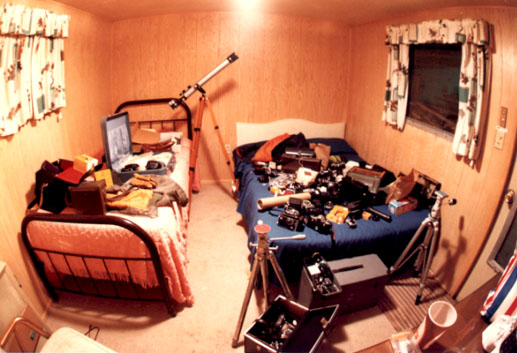
| |
| Jumble of Equipment for the 1979 Eclipse Crammed into in our Motel Room. | |
| The eight foot wide motel room was rather crowded, but it was only $14.95 per night for three people! My jumbled equipment is on the floor and the bed to the right. I was more organized (and brought less stuff) on subsequent eclipse expeditions. One of the best improvements one can make is to mount multiple items on a tripod. This results in fewer tripods, which radically reduces the total amount of baggage that must be transported. |
|
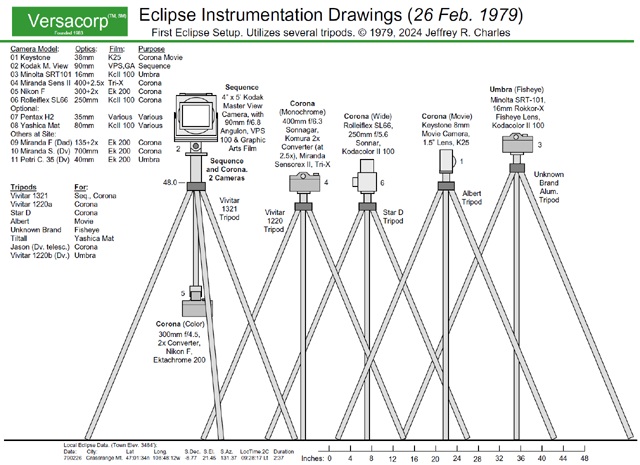
| |
| Drawing of Cameras and Tripods used at the 26 Feb. 1979 Total Solar Eclipse. | |
| Drawing of equipment used at the Total Solar Eclipse of 26 February, 1979. This was my first total solar eclipse. Objectives were only observation and photography. There were no experiments, though (after the fact) I was able to get some light intensity data for totality, and up to about a minute before totality, from my photos. Copyright 1979, 2024 Jeffrey R. Charles, All Rights Reserved. This is a low resolution 640 pixel wide image. Click HERE for a larger image (1650 x 1200, 476 KB) | |
| Place Holder for 1979 Total Solar Eclipse Equipment PHOTO. | |
|
Caption TBD. Copyright 2024 Jeffrey R. Charles, All Rights Reserved. | |
| Goals of the 1979 Total Solar Eclipse Expedition:
Results from the 1979 Total Solar Eclipse The following results were obtained at the 1979 eclipse:
| |
| Copyright 1979, 1997, 2024 Jeffrey R. Charles, All Rights Reserved. | |
Return to Local Table of Contents
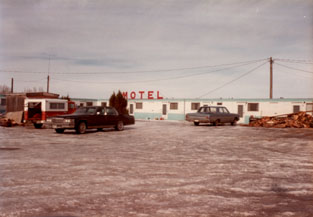 |
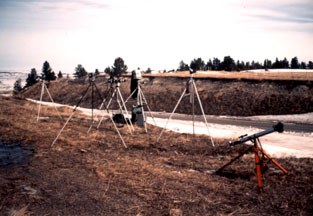 |
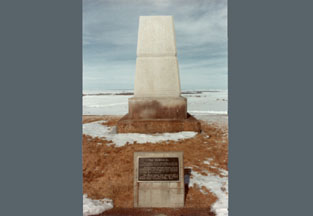 |
 |
| Pictures of Montana (Motel, Eclipse Site, Custer Battlefield) | |
| TOP LEFT: Icy parking lot in front of our Motel in Grassrange, Montana. TOP RIGHT: Equipment set up at our eclipse site, three kilometers south of Grassrange. LOWER LEFT: Monument at the Custer Battlefield National Monument in Montana. (The name was changed to the "Little Bighorn Battlefield National Monument" in 1991.) LOWER RIGHT: Diorama of the battle. One of many displays in the visitor center. |
|
Return to Local Table of Contents
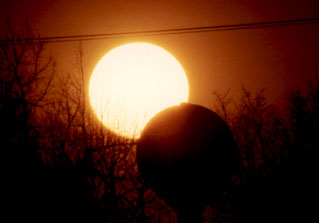 |
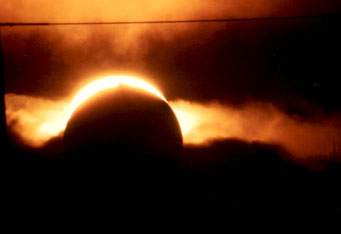 |
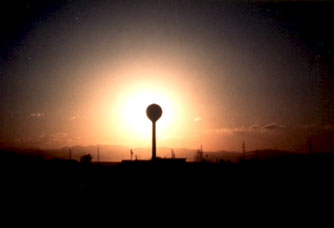 |
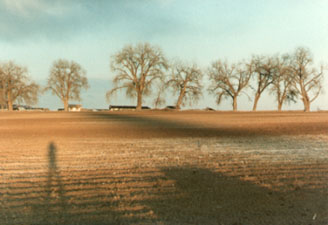 |
| Poor Man's "Eclipse": Chasing the Shadow of a Spherical Water Tower! | |
| The 1979 eclipse had me so hooked that I did not want to wait for the next "real" eclipse. In my more eccentric attempts at creating an artificial eclipses, I chased the shadow of a spherical water tower near where I worked west of Greeley, CO. Due in part to the low elevation angle of the sun, this technique does not reveal the corona, but it sure was fun to try at the time! A solar filter was not used for the pictures, but I did use one to visually observe the "partial eclipse" phases. UPPER LEFT: The sun is partially eclipsed by the water tower, but it is also getting behind some trees. UPPER RIGHT: The sun is eclipsed even more, but local clouds are beginning to interfere, though they do create an interesting effect. LOWER LEFT: Totality! (Well, sort of anyway.) LOWER RIGHT: The "umbra" of the water tower, as it races away from me. Due to the low elevation angle of the sun and the low angle of the shadow cone, the ground speed of the tower's "umbra" is several km per hour! | |
Return to Local Table of Contents
|
Recommended Reading:
Light intensity graph for the 1995 eclipse, by Jeffrey R. Charles Steps to a Successful Eclipse Expedition, by Jeffrey R. Charles SYZYGY: A novel and screenplay based in part on my eclipse chasing experiences Archived 12 June, 1998 version of this 1979 Eclipse Image web page Use of material herein is subject to conditions in the Versacorp Legal Information Page Need information about eclipses for your planetarium, motion picture, or other project? Jeffrey R. Charles performs science consulting in regard to eclipse phenomena and instrumentation. Please direct inquiries to Jeffrey R. Charles (jcharles *at* versacorp dot com) or visit www.versacorp.com for more information about total solar eclipse related science and engineering consulting. |
| Return to Local Table of Contents |
|
© Copyright 1979, 1998, 2017, 2024, 2025 Jeffrey R. Charles. All Rights Reserved.
Mail to: Jeffrey R. Charles (jcharles *at* eclipsechaser dot com)
Document created: 17 March, 1998 |
